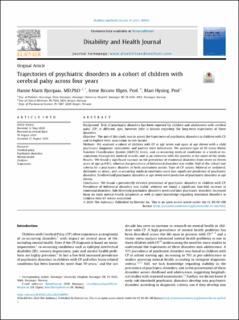| dc.contributor.author | Bjørgaas, Hanne Marit | |
| dc.contributor.author | Elgen, Irene Bircow | |
| dc.contributor.author | Hysing, Mari | |
| dc.date.accessioned | 2021-07-15T12:41:36Z | |
| dc.date.available | 2021-07-15T12:41:36Z | |
| dc.date.created | 2021-02-25T15:24:22Z | |
| dc.date.issued | 2021 | |
| dc.identifier.issn | 1936-6574 | |
| dc.identifier.uri | https://hdl.handle.net/11250/2764545 | |
| dc.description.abstract | Background: Risk of psychiatric disorders has been reported for children and adolescents with cerebral palsy (CP) at different ages, however little is known regarding the long-term trajectories of these disorders.
Objective: The aim of this study was to assess the trajectories of psychiatric disorders in children with CP, and to explore their association to risk factors.
Methods: We assessed a cohort of children with CP at age seven and again at age eleven with a child psychiatric diagnostic instrument, and parents were informants. We assessed type of CP, Gross Motor Function Classification System (GMFCS) levels, and co-occurring medical conditions in a medical examination, through the medical records, and in an interview with the parents at the onset of the study.
Results: We found a significant increase in the prevalence of emotional disorders from seven to eleven years of age (p 0.01), whereas the prevalence of behavioral disorders was stable. Half of the cohort met criteria for a psychiatric disorder at both assessment points. Type of CP, spastic bilateral or unilateral, dyskinetic or ataxic, and co-occurring medical conditions were non-significant predictors of psychiatric disorders. Subthreshold psychiatric disorders at age seven were predictive of psychiatric disorders at age eleven.
Conclusions: We found a persistently elevated prevalence of psychiatric disorders in children with CP. Prevalence of behavioral disorders was stable, whereas we found a significant four-fold increase in emotional disorders. Sub-threshold psychiatric disorders predicted later psychiatric disorders. Increased focus on early mental health symptoms as well as more knowledge regarding emotional disorders in children with CP seems warranted. | en_US |
| dc.language.iso | eng | en_US |
| dc.publisher | Elsevier | en_US |
| dc.rights | Attribution-NonCommercial-NoDerivatives 4.0 Internasjonal | * |
| dc.rights.uri | http://creativecommons.org/licenses/by-nc-nd/4.0/deed.no | * |
| dc.title | Trajectories of psychiatric disorders in a cohort of children with cerebral palsy across four years | en_US |
| dc.type | Journal article | en_US |
| dc.type | Peer reviewed | en_US |
| dc.description.version | publishedVersion | en_US |
| dc.rights.holder | Copyright 2020 the authors | en_US |
| dc.source.articlenumber | 100992 | en_US |
| cristin.ispublished | true | |
| cristin.fulltext | original | |
| cristin.qualitycode | 1 | |
| dc.identifier.doi | 10.1016/j.dhjo.2020.100992 | |
| dc.identifier.cristin | 1893768 | |
| dc.source.journal | Disability and Health Journal | en_US |
| dc.identifier.citation | Disability and Health Journal. 2021, 14 (1), 100992. | en_US |
| dc.source.volume | 14 | en_US |
| dc.source.issue | 1 | en_US |

